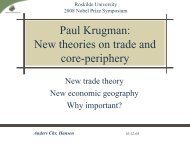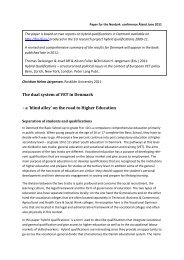Abstractbog printer - ansatte - Roskilde Universitet
Abstractbog printer - ansatte - Roskilde Universitet
Abstractbog printer - ansatte - Roskilde Universitet
You also want an ePaper? Increase the reach of your titles
YUMPU automatically turns print PDFs into web optimized ePapers that Google loves.
Abstracts - Posters<br />
P9. Wind induced anomalies in the ocean heat transport over the North<br />
Atlantic<br />
Francesco Emanuele Bucci<br />
University of Copenhagen – Niels Bohr Institute fra.ema.bucci@gmail.com<br />
Results are presented from a study on the relationship between atmospheric blocking effects above<br />
the North Atlantic and the variability of the North Atlantic ocean. In the article entitled<br />
“Atmospheric Blocking and Atlantic Multidecadal Ocean Variability” (Sirpa Haekkinen, Peter B.<br />
Rhines and Denis L. Worthen, Science 2011) it is proposed that there is a connection between the<br />
frequency of atmospheric blocking events above the North Atlantic ocean and the circulation of the<br />
North Atlantic ocean. It is proposed that the persistence of blocking effect for many days during one<br />
winter could affect the variability of the ocean for decades: one explanation could be that the wind<br />
forcing over the northern North Atlantic changes significantly and this would affect the wind driven<br />
circulation of the North Atlantic and modify the extension of the subpolar gyre circulation. This<br />
would imply changes in the northward heat transport and increased influx of warm water from<br />
subtropical latitudes into the northern North Atlantic.The influence from the relatively short term<br />
blocking effects, with time scales of days to weeks, on the large scale circulation is analysed in a<br />
sensitivity study with the ocean general circulation model NEMO. The chosen configuration<br />
includes the ocean module and the sea-ice module; an atmospheric forcing is applied from the<br />
NCAR/NCEP reanalysis. The ocean model works on a global configuration, with an horizontal<br />
resolution of 1 degree at the equator and 46 vertical levels. The atmospheric forcing comes from<br />
one of the dataset analyzed by Haekkinen, the NCEP/NCAR reanalysis (Kalnay et al.,The<br />
NCEP/NCAR 40-year reanalysis project, Bull. Amer. Meteor. Soc., 77, 437-470, 1996) derived<br />
from an analysis-forecast system with the assimilation of data since the 1948.<br />
An EOF analysis has been done on the curl of the wind stress above the North Atlantic: the wind<br />
stress curl is used as index of the strength of the gyre circulation. A seasonal signal propagates over<br />
the decades and a correlation with the anomalous blocking events is examined.<br />
A sensitivity experiment is performed through the model in order to find a correlation between<br />
anomalous blocking events and the variability of the ocean circulation. The meridional heat<br />
transport is investigated in order to study the mechanism of influx of warm waters due to the wind<br />
anomalies.<br />
Program 17. danske havforskermøde, 126











